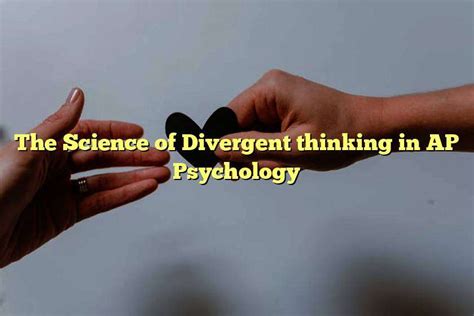Divergent thinking, a cornerstone of AP Psychology, is the ability to generate multiple, unconventional solutions to a problem. Unlike convergent thinking, which focuses on finding a single correct answer, divergent thinking embraces a wide array of perspectives and ideas.

Defining Divergent Thinking
According to the American Psychological Association (APA), divergent thinking involves:
- Fluency: Generating a large number of ideas
- Flexibility: Shifting between different perspectives
- Originality: Proposing novel and unique solutions
- Elaboration: Expanding on and refining ideas
The Importance of Divergent Thinking
Divergent thinking is crucial for:
- Problem-solving: Exploring diverse solutions expands options and increases the likelihood of finding an effective approach.
- Innovation: Generating original ideas fuels progress and advancements in various fields.
- Creativity: Unconstrained thinking fosters imagination and the generation of artistic or literary masterpieces.
Measuring Divergent Thinking
Psychologists assess divergent thinking using various measures, including:
- Torrance Tests of Creative Thinking: Evaluates fluency, flexibility, originality, and elaboration.
- Guilford’s Divergent Production Tests: Measures fluency and flexibility of thinking.
- Remote Associates Test: Assesses problem-solving and insight through indirect associations.
Characteristics of Divergent Thinkers
Research suggests that divergent thinkers tend to exhibit:
- Open-mindedness: Accepting and considering diverse perspectives
- Curiosity and exploration: Constantly seeking knowledge and new experiences
- A tolerance for ambiguity: Embracing uncertainty and non-rigid thinking
Practical Applications of Divergent Thinking
Divergent thinking has applications across various domains, including:
- Business: Generating innovative solutions to market challenges or developing new products.
- Education: Fostering creative problem-solving and critical thinking in students.
- Healthcare: Expanding diagnostic options and developing novel treatments.
Strategies to Enhance Divergent Thinking
- Brainstorming: Conducting open-ended discussions to generate a multitude of ideas.
- Mind mapping: Visually organizing ideas and exploring their interconnections.
- Freewriting: Writing down ideas without censorship or editing.
- Role-playing: Assuming different perspectives to generate diverse solutions.
Table 1: Examples of Divergent Thinking in Different Fields
| Field | Examples |
|---|---|
| Science | Developing a vaccine for a newly discovered disease |
| Business | Designing a marketing campaign to target a niche audience |
| Art | Creating a painting that conveys a complex emotion through abstract shapes |
| Education | Restructuring a curriculum to make it more engaging for students |
Table 2: Measurement Techniques for Divergent Thinking
| Technique | Description |
|---|---|
| Torrance Tests of Creative Thinking | Assesses multiple aspects of divergent thinking, including fluency and originality |
| Guilford’s Divergent Production Tests | Measures fluency and flexibility of thinking |
| Remote Associates Test | Evaluates problem-solving and insight through indirect associations |
| Figural Fluency Test | Assesses the ability to generate novel solutions to figural problems |
Table 3: Strategies to Enhance Divergent Thinking
| Strategy | Description |
|---|---|
| Brainstorming | Conducting open-ended discussions to generate multiple ideas |
| Mind mapping | Visually organizing ideas to explore their interconnections |
| Freewriting | Writing down ideas without censorship or editing |
| Role-playing | Assuming different perspectives to generate diverse solutions |
Table 4: Benefits of Divergent Thinking
| Benefit | Description |
|---|---|
| Increased problem-solving | Generating multiple solutions expands options for finding effective approaches |
| Boosted innovation | Original ideas fuel progress and advancements |
| Enhanced creativity | Unconstrained thinking fosters imagination and artistic expression |
| Improved decision-making | Considering diverse perspectives leads to more informed decisions |
Conclusion
Divergent thinking is a powerful tool for expanding perspectives, generating innovative solutions, and fostering creativity. By understanding its definition, characteristics, and practical applications, individuals can harness its potential to unlock their full intellectual capabilities.
